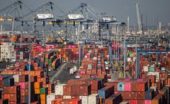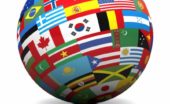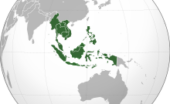Molly Minturn - My family is heartbroken to share that my father died in surgery on Monday, Feb. 10. It…
Water (1)
Written by Diana Thebaud Nicholson // November 21, 2008 // Water // Comments Off on Water (1)
More on Water and on Wednesday-Night.com Thirst a powerful slide show on water ; Stockholm International Water Institute ;Nanotechnology for clean water ; (IPS files) Troubled Waters ; Economist Special Report on Water
2 June 2000 — Dawn of a thirsty century
The amount of water in the world is limited. The human race, and the other species which share the planet, cannot expect an infinite supply.
Water covers about two-thirds of the Earth’s surface, admittedly. But most is too salty for use.
Population is rising, but water supplies are not
Only 2.5% of the world’s water is not salty, and two-thirds of that is locked up in the icecaps and glaciers.
Of what is left, about 20% is in remote areas, and much of the rest arrives at the wrong time and place, as monsoons and floods.
Humans have available less than 0.08% of all the Earth’s water. Yet over the next two decades our use is estimated to increase by about 40%
21 November 2008
Blue Is the New Green A thoughtful analysis along with concrete examples and some great pictures of practical and attractive initiatives.
A range of alternative energy technologies are available to us today; there is, however, no substitute for water. But there are new ways of thinking about water that can help us make better use of the available supply.
Maude Barlow named 1st UN water adviser
Canadian activist Maude Barlow has been appointed as the United Nation’s first senior adviser on water issues, a role she hopes to use to establish water as a human right and to convince Canada to “change its shameful position” on the issue.
“This is a wonderful opportunity to advance a more democratic and transparent method of policy making around water at the global level than now exists,” Barlow said in a press release. “Water is a commons, a public trust and a human right.” Barlow said there’s “growing momentum” in the international community for water justice but will focus some of her attention on her home country.
“I also plan to take this opportunity to get the Canadian government to change its shameful position, and to finally join the international community in recognizing water as a human right,” said Barlow.
19 September
The world has a water shortage, not a food shortage
(The Economist) MOST people drink about 2 litres of water a day, but consume 3,000 a day if the water that goes into their food is taken into account. Rich countries use more as their consumption of meat, which is far more water-intensive than grain, is higher. Around 1.2 billion people live in places that are short of water, and it is running out in others such as northern China and western America. Meanwhile, the world’s population is growing and more water will be needed to feed it. Farming, which accounts for some 70% of human water consumption, offers the best opportunity for thrift. Repairing leaks and better irrigation in poor countries could help reduce wastage by up to 70%, as could switching to less thirsty crops in arid regions.
11 September
Australia Govt Buys Huge Farm to Save Dying River
(Reuters/Planet Ark) CANBERRA – An irrigation farm larger than Singapore and sucking up billions of litres of water each year has been bought by Australia’s government to help save one of the country’s most vital rivers from a slow death and climate change.
9 September
Global change leading to declining water supplies in specific regions
Regions whose water level has typically run low — the Middle East, North Africa, and stretches of Central Asia — are now reaching historic levels of drought. Yemen is near to depleting its water table, Kyrgyzstan is cutting electricity to preserve water, and the Sea of Galilee has reached its lowest record ever. Climate change is likely to lead areas like the Middle East to begin importing a much greater percentage of the food it consumes, since agriculture consumes so much water. The Guardian (London) (9/9)
1 September
Tajikistan Hopes Water Will Power Its Ambitions
Tajikistan [is] the source of more than 40 percent of Central Asia’s water. The mountainous state lacks the industry and natural riches that bless other former Soviet Central Asian republics. Water is one of the few resources the country possesses in great abundance.
For this reason, President Emomali Rakhmon has pinned Tajikistan’s economic hopes — and perhaps even its continued political existence — on developing its hydropower potential.
Three projects are either under construction or being considered, including Rogun, a gargantuan structure farther up the Vakhsh River. Tajik officials say they have hopes of building more than 20 hydroelectric plants and dams.
Exporting bulk water is the wrong way to go
Canada should use its abundant water to generate economic wealth
KAREL MAYRAND and JAY RITCHLIN, Freelance
Proponents of water exports base their rationale on the notion of surplus water that is lost to the sea and the fact that water shipments would be equivalent to a drop in a bucket.
But the science is clear: There is no such thing as surplus water. Ecosystems and humans need all available water. The impact of large water diversions or the cumulative impact of numerous water withdrawals will certainly affect our water resources and ecosystems. This impact could be devastating in some areas. The risk is even greater when one considers the likely impact of climate change on our water resources, especially in the Great Lakes basin, which is so vulnerable to evaporation.
Karel Mayrand is the David Suzuki Foundation’s director-general for Quebec. Jay Ritchlin is the foundation’s director for marine and freshwater conservation.
27 August
Exporting water: a wealth-generating opportunity for Quebec?
At a time when some countries are running out of water, its economic development sparks opposition in Canada. Is mass exportation of our fresh water a wealth-generating idea? While some fear abusive exploitation or even the drying up of our water resources, others are convinced that the development of our blue gold is an urgent matter. Marcel Boyer will present this second point of view, by showing why and how water markets could be beneficial for both Canada and the United States. An expert panel will discuss these ideas at a luncheon meeting of the Montreal Economic Institute.
Global water consumption unsustainable
Global water consumption, driven by increasing population, climate change and rising demand in developing countries, is straining the world’s supply of fresh water to the breaking point. International delegates will gather this week in Stockholm for the annual World Water Week conference to look at ways to increase availability without further damaging supply. The Economist (8/21)
25 August
Catch it when you can
(The Age) EARLY this year Melbourne Water chief Rob Skinner laid his cards on the table. Melbourne, he said, had no choice: it needed a desalination plant to augment its dwindling water supply.
Other options such as rainwater tanks were not up to the task. Tanks, he said, were too small and too expensive. If everybody in Melbourne installed a 2500-litre rainwater tank and connected it by a pump to their gardens and toilets we would save an estimated 50 billion litres a year, he said. That, he said, was about a fifth of the water that would be generated through the proposed desalination plant at Wonthaggi and the north-south pipeline.
Skinner estimated the cost of installing a tank in every Melbourne house at between $2 billion and $5 billion. At $4.9 billion, the Government’s water plan, which includes the desalination plant, was better value for Melburnians. Skinner’s view seemed to capture the mood of a Government anxious to drought-proof Melbourne and pollproof itself through big-ticket engineering solutions timed to come on stream just before, and after, the 2010 election.
His comments may have sounded like the final judgement on the longrunning debate about the right path for Melbourne’s water future. But it is far from the case. Despite last year’s engineering-heavy water plan, debate still rages within, and outside of, the Government about the relative environmental and financial costs and benefits of decentralised strategies such as tanks and stormwater collection versus the centralised engineering solutions, including desalination and the pipeline. More on water issues
24 July
Our Great Lakes Are in Crisis!
(Nature Canada) The Great Lakes region – Ontario and Quebec plus eight U.S. states – is home to 103 million people. If it were taken as a country the Great Lakes regional non-farm economy, at $4.1 trillion GDP, would be ranked as the third largest in the world, after only the United States and Japan.
Water. We Can’t Live Without It
Without clean, abundant freshwater life on earth would not exist. The majority of the world’s population depends on freshwater environments to provide water for drinking, irrigation, food, employment and recreation.
16 and 23 July
The two Stratfor reports linked to below present a disturbing view of prevailing concerns over the safety of precious water supplies – and whether or not they are well-founded.
Water Over the Dam
… Like many other potential targets, the drinking water system is vulnerable to attack. In fact, it could be easily attacked — though such an undertaking would most likely be unsuccessful at creating mass casualties. Like the 2001 anthrax attacks, however, such an event could trigger mass panic that would cause far more disruption and economic impact than the immediate effects of the plot itself.
Another Dam Threat
At the stroke of midnight July 8, the Denver Water Board closed the road over Dillon Dam in Summit County, Colorado, citing security concerns.
20 May
Climate Change Refugees
As global warming tightens the availability of water, prepare for a torrent of forced migrations
Jeffrey Sachs
(Scientific American) Human-induced climate and hydrological change is likely to make many parts of the world uninhabitable, or at least uneconomic. Over the course of a few decades, if not sooner, hundreds of millions of people may be compelled to relocate because of environmental pressures.
To a significant extent, water will be the most important determinant of these population movements. Dramatic alterations in the relation between water and society will be widespread, as emphasized in the new report from Working Group II of the Intergovernmental Panel on Climate Change. These shifts may include rising sea levels, stronger tropical cyclones, the loss of soil moisture under higher temperatures, more intense precipitation and flooding, more frequent droughts, the melting of glaciers and the changing seasonality of snowmelt.
24 April
(RCI) TORONTO: ‘WATER WARS’ LOOM
Experts speaking at a conference on water warn that “water wars” are impending, particularly over water from the Great Lakes. Linda Mortsch of Environment Canada noted that the southwestern U.S. states are already worried about dwindling water supplies and the impacts of climate change are worsening their problem. Earlier this month, Ohio Lt.-Gov. Lee Fisher created a stir when he predicted that the Great Lakes region may be less than a decade away from selling water to other U.S. states in need. Mrs. Mortsch commented that many Americans think such an eventuality is inevitable. Milton Clark, a senior health and science adviser for the U.S. Environmental Protection Agency, remarked: “You will see water wars coming in every way, shape or form.” Mr. Clark added that there are leading American politicians who have insisted that the Great Lakes belong to everyone and that water should be nationalized. Ontario and Quebec have signed an agreement that would ban bulk transfers of Great Lakes water to other jurisdictions and are hoping that the eight Great Lakes states and the U.S. Congress will agree to a similar accord.
UN’s climate panel predicts water woes
The world’s southern hemisphere is likely to suffer more droughts in coming decades while the northern hemisphere probably will see more floods, the United Nations’ climate panel predicts in a new report. The report, which was presented at a meeting in Budapest, said there likely will be less water in the south for both drinking and agriculture. Chicago Tribune/Associated Press (free registration) (4/10)
5 April
Water
The first imperative chosen for the Gii [Global Innovation Initiatives] program on water was launched in New Orleans in April 2008. The decision to focus on water needs little explanation. Drinkable water, for many, is a scarce resource. Water in the quantities needed to sustain industry is becoming a challenge. Ensuring a reliable supply of water is a global issue.
Spring 2008
The Council of Canadians on water
Water is vital to people’s health and livelihoods. In Canada, there is no national strategy to address urgent water issues and no federal leadership to conserve and protect our water. The Federal Water Policy is over 20 years old and badly outdated. Our freshwater faces crises including contamination, shortages and pressure to export water to the United States through pipelines and diversions. 2008 General Water Presentation:
22 March
(Reuters) World Water Day: 1.5 million children’s lives could be saved if provided with proper water and sanitation
World Water Day today: 1.1 bn lack access to water
As the world celebrates World Water Day on Saturday, nearly 1.1 billion people lack access to safe drinking water, it requires 100 tonnes of water to produce one ton of grain and food security is under threat. The UN, which has been celebrating World Water Day for last fifteen years, reported this week that the world’s glaciers are melting at “an alarming rate.” Like reservoirs, glaciers store water and then release it at predictable rates, around which humans have formed communities and built economies. Achim Steiner, executive director of the United Nations Environment Program recently said, “Millions if not billions of people depend directly or indirectly on these natural water storage facilities for drinking water, agriculture, industry, and power generation during key parts of the year.”
(Pakistan Daily Times) World Water Day: Water shortage looms high
* World Bank report says Pakistan in dire need of new reservoirs
* More water resources required to meet electricity demand
* New dams required to fulfil industrial demands
* Data say only 55pc population has access to drinking water
We offer the piece below for entertainment – it’s well written – but also as a bitter contrast of two separate worlds. Unfortunately, it is based on a false premise. Water is a finite and precious resource.
Water – not a finite resource?
Water has become the toast of self-righteousness. This is stupid, lazy, T-shirt-slogan morality. Bottled water is ethically, intellectually and environmentally indistinguishable from bottled anything else. There is a real world problem with water: it’s the indiscriminate drilling of wells in the Punjab, the salination of central Asia, the contamination of the water table under the Middle East, the cholera and dysentery in sub-Saharan Africa, the evaporation of Lake Chad, the drought in central-southern Australia and the fact that 1.1 billion people can’t get a clean, clear drink. So do you imagine the sort of ethically filtered aqua you sip matters a drip to a woman who has to walk four miles to fill a bucket with brown amoebic sludge?
 Aral, the dying sea
Aral, the dying sea
Once the world’s fourth largest lake, the mighty Aral Sea is now in it’s death throws. Starved of it’s lifeblood of the waters of the Syr Darya and the Amu Darya rivers, the sea has been shrinking for the last 40 years.
From the 1930s, the former Soviet Union started building large scale diversion canals to irrigate vast cotton fields in a grand plan to make cotton a great export earner. This was achieved, and even today Uzbekistan is still a large exporter of cotton. But the cost in ecological and human terms have been astronomical.
20 August 2007
Warming Will Exacerbate Global Water Conflicts
26 June
Averting water wars in Asia
(IHT op-ed) Tibet’s vast glaciers and high altitude have endowed it with the world’s greatest river systems. Its rivers are a lifeline to the world’s two most-populous states – China and India – as well as to Bangladesh, Burma, Bhutan, Nepal, Cambodia, Pakistan, Laos, Thailand and Vietnam. These countries make up 47 percent of the global population.
Yet Asia is a water-deficient continent. Although home to more than half of the human population, Asia has less fresh water – 3,920 cubic meters per person – than any continent other than the Antarctica.
…The looming struggle over water resources in Asia has been underscored by the spread of irrigated farming, water-intensive industries and a growing middle class that wants high water-consuming comforts like washing machines and dishwashers. Household water consumption in Asia is rising rapidly, although several major economies there are acutely water-stressed.
The specter of water wars in Asia is also being highlighted by climate change and environmental degradation in the form of shrinking forests and swamps that foster a cycle of chronic flooding and droughts. The Himalayan snow melt that feeds Asia’s great rivers could be accelerated by global warming.
16 June
A Sacred River Endangered by Global Warming
(Washington Post) … the prayer rituals carried out at the water’s edge may not last forever — or even another generation, according to scientists and meteorologists. The Himalayan source of Hinduism’s holiest river, they say, is drying up.The Gangotri glacier, which provides up to 70 percent of the water of the Ganges during the dry summer months, is shrinking at a rate of 40 yards a year, nearly twice as fast as two decades ago, scientists say.
“This may be the first place on Earth where global warming could hurt our very religion. We are becoming an endangered species of Hindus,” said Veer Bhadra Mishra, an engineer and director of the Varanasi-based Sankat Mochan Foundation, an organization that advocates for the preservation of the Ganges. Environmental groups such as Mishra’s have long focused on pollution of the Ganges. More than 100 cities and countless villages are situated along the 1,568-mile river, which stretches from the foothills of the Himalayas to the Bay of Bengal, and few of them have sewage treatment plants. But recent reports by scientists say the Ganges is under even greater threat from global warming. According to a U.N. climate report, the Himalayan glaciers that are the sources of the Ganges could disappear by 2030 as temperatures rise.
The shrinking glaciers also threaten Asia’s supply of fresh water. The World Wildlife Fund in March listed the Ganges among the world’s 10 most endangered rivers. In India, the river provides more than 500 million people with water for drinking and farming.
April 2007
The supply of potable water is declining. While climate change plays a part in affecting global water supplies, it is the pressure of increasing population growth that is at the root of the problem. Growing urban water supply and sanitation needs, particularly in lower- and middle-income countries, face increasing competition with other sectors. Rising incomes in other portions of the world population fuel demand for manufactured goods and environmental services and amenities, all of which require water. [see: 2nd UN World Water Development Report]
30 September 2006
India Digs Deeper, but Wells Are Drying Up
Mr. Yadav’s words could well prove prophetic for his country. Efforts like his — multiplied by some 19 million wells nationwide — have helped India deplete its groundwater at an alarming pace over the last few decades.
The country is running through its groundwater so fast that scarcity could threaten whole regions like this one, drive people off the land and ultimately stunt the country’s ability to farm and feed its people.
With the population soaring past one billion and with a driving need to boost agricultural production, Indians are tapping their groundwater faster than nature can replenish it, so fast that they are hitting deposits formed at the time of the dinosaurs.
A passionate fighter Maude Barlow
by Ann Farrell | January 2, 2003
The global water crisis is undeniable The Council of Canadians (COC) told Prime Minister Stephen Harper in a letter sent on the occasion of the 2007 International Women’s Day. The letter re-iterates what COC’s national volunteer chairman Maude Barlow wrote nearly 20 years ago in her book Parcel of Rogues:
… They (environmentalists) also point out that the Athabasca venture alone will dump tons of dioxin into the river every day. The industry is responsible for half the waste water dumped in Canada every year.
The 60-year-old Barlow believes the “commodifying” of water – selling it in bottles, for instance – has been driven by corporate interests. She said this started with the privatization of municipal water services and was encouraged when water was declared a commodity or a good in trade agreements. It was talked about as a good rather than as a need, and with the founding of the World Water Council in 1997, the commodification of water was launched.
16 March
State of the World’s Water Resources
10 March
NAIROBI, Kenya — Mismanagement, limited resources and environmental damage have combined to deny 1.1 billion people access to safe water, a U.N. report said Thursday.
Sub-Saharan Africa is one of the hardest-hit areas, where ecological degradation, poor management and a burgeoning population have led to water shortages exacerbating poverty, disease and drought, the report said.
Scientists Say Risk of Water Wars Is Rising
August 24, 2004 12:00 AM – Patrick McLoughlin, Reuters
The risk of wars being fought over water is rising because of explosive global population growth and widespread complacency, scientists said recently.
April 26, 2001
Shrinking African Lake Offers Lesson on Finite Resources
Lake Chad, once one of Africa’s largest freshwater lakes, has shrunk dramatically in the last 40 years.
The situation is a “domino effect,” the researchers say. Overgrazing reduces vegetation, which in turn reduces the ecosystem’s ability to recycle moisture back into the atmosphere. That contributes to the retreat of the monsoons. The consequent drought conditions have triggered a huge increase in the use of lake water for irrigation, while the Sahara has gradually edged southward. Lake Chad is not likely to be replenished to its former size in our lifetime, the researchers say. The lake’s decline and the climate change have had an enormous impact on the 9 million farmers, fishermen, and herders living in the region. They have experienced crop failures, dying livestock, collapsed fisheries, and the continuous draining of the lake.



